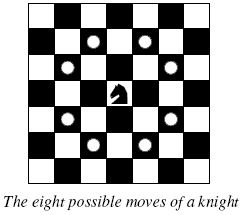A Knight's Journey
| Time Limit: 1000MS | Memory Limit: 65536K | |
| Total Submissions: 34660 | Accepted: 11827 |
Description
 Background
Background
The knight is getting bored of seeing the same black and white squares again and again and has decided to make a journey
around the world. Whenever a knight moves, it is two squares in one direction and one square perpendicular to this. The world of a knight is the chessboard he is living on. Our knight lives on a chessboard that has a smaller area than a regular 8 * 8 board, but it is still rectangular. Can you help this adventurous knight to make travel plans?
Problem
Find a path such that the knight visits every square once. The knight can start and end on any square of the board.
Input
The input begins with a positive integer n in the first line. The following lines contain n test cases. Each test case consists of a single line with two positive integers p and q, such that 1 <= p * q <= 26. This represents a p * q chessboard, where p describes how many different square numbers 1, . . . , p exist, q describes how many different square letters exist. These are the first q letters of the Latin alphabet: A, . . .
Output
The output for every scenario begins with a line containing "Scenario #i:", where i is the number of the scenario starting at 1. Then print a single line containing the lexicographically first path that visits all squares of the chessboard with knight moves followed by an empty line. The path should be given on a single line by concatenating the names of the visited squares. Each square name consists of a capital letter followed by a number.
If no such path exist, you should output impossible on a single line.
If no such path exist, you should output impossible on a single line.
Sample Input
3 1 1 2 3 4 3
Sample Output
Scenario #1: A1 Scenario #2: impossible Scenario #3: A1B3C1A2B4C2A3B1C3A4B2C4
Source
TUD Programming Contest 2005, Darmstadt, Germany
题目链接:http://poj.org/problem?id=2488
题目大意:一个有n*m个格子的棋盘,模拟马走“日”字,求一个棋盘的所有格子能否被走完,如果能,求走的路径,即走格子的先后顺序,如果有多种情况,按字典序最小的情况。用横纵坐标表示格子位置,横坐标是字母,纵坐标是数字。
解题思路:DFS由第一个格子开始搜,因为每步只能走“日”字,所以每步有八个方向,因为按字典序最小的走,枚举方向时也按字典序。找到解的返回过程中标记路径。
代码如下:
#include <cstdio>
#include <cstring>
int dx[8]={-2,-2,-1,-1,1,1,2,2};//按字典序枚举8个方向
int dy[8]={-1,1,-2,2,-2,2,-1,1};
int xx[26]={'A','B','C','D','E','F','G','H','I','J','K','L','M','N','O','P','Q','R','S','T','U','V','W','X','Y','Z'};
char ansx[28]; //记录横坐标路径
int ansy[28]; //记录纵坐标路径
int sum,m,n,j;
bool p;
int a[28][28],vis[28][28];
void dfs(int x,int y,int cnt)
{
if(cnt==sum) //已走完所有格子
{
ansx[j]=xx[x];
ansy[j++]=y+1;
p=true;
return;
}
for(int i=0;i<8;i++)
{
if(x+dx[i]<0||x+dx[i]>=n||y+dy[i]<0||y+dy[i]>=m)
continue;
if(vis[x+dx[i]][y+dy[i]])
continue;
vis[x+dx[i]][y+dy[i]]=1;
dfs(x+dx[i],y+dy[i],cnt+1);
if(p) //若成功走完格子,往前标记每步路径
{
ansx[j]=xx[x];
ansy[j++]=y+1;
return;
}
vis[x+dx[i]][y+dy[i]]=0;
}
}
int main()
{
int t;
scanf("%d",&t);
for(int cnt=1;cnt<=t;cnt++)
{
p=false,j=0;
memset(vis,0,sizeof(vis));
vis[0][0]=1;
scanf("%d%d",&m,&n);
sum=n*m;
dfs(0,0,1);
printf("Scenario #%d:\n", cnt);
if(!p)
printf("impossible\n");
else //输出路径
{
for(int i=j-1;i>=0;i--)
printf("%c%d",ansx[i],ansy[i]);
printf("\n");
}
if(cnt<t)
printf("\n");
}
return 0;
}





















 787
787

 被折叠的 条评论
为什么被折叠?
被折叠的 条评论
为什么被折叠?








